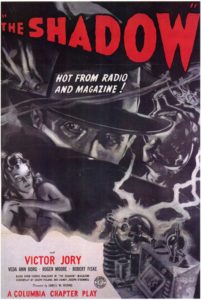
You are about to read an excerpt from my new book The Shadow in Review. At the end of this blog entry, you will find a shamless promotion for the book. But now, here is a look at one of pulpdom’s greatest serial accomplishments.
On Jan. 1, 1940, Columbia studios released its theatrical serial based upon The Shadow. And for the next 15 Saturday afternoons, an audience composed of mainly adolescent boys thrilled to the cinematic adventures of the master of the night. The character is The Shadow from the pulps, not from the radio show. The Shadow wears black gloves, a long black cloak, and slouch hat, and fights crime without the ability to become invisible. Yup, that’s the pulp character, all right!
Lamont Cranston is no longer a wealthy world traveler and man-about-town. Here he’s an eminent scientist and criminologist. He owns a chemical company and has his own building, with a metal plaque outside that reads “Cranston Research Building.” In the serial, The Shadow is a disguise of Lamont Cranston. In the pulps, as we know, it’s the other way around. Lamont Cranston is a disguise of The Shadow.
Interestingly, when The Shadow speaks over the phone to Commissioner Weston in chapter one, the filmmakers dubbed someone else’s voice. Was that so Weston wouldn’t recognize The Shadow as Cranston? It only occurred once in the serial, and reference to it was never made, so I’m not sure what was the purpose.
And our master villain
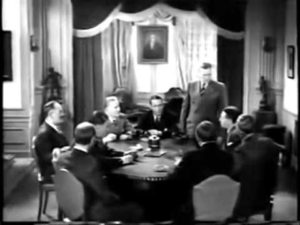
The plot has to do with a sinister figure known as The Black Tiger. He’s an industrialist out to acquire supreme financial power. Although The Shadow lacks the ability to become invisible, The Black Tiger has discovered that very secret. An invisible villain! Now that’s pretty tough to fight. Cranston eventually figures out it must be someone on a committee of businessmen who regularly meet at the Cobalt Club.
About the only thing borrowed from the radio version was the character of Margot Lane. (Margot spelled with a “t” was the radio spelling; in the pulps, her name was spelled “Margo.”) She didn’t appear in the pulp stories until a year and a half after the serial release.
Margot is a blond in the serial. In the pulps she was a brunette; in the radio show, too, I believe. She’s not just Cranston’s “lovely young friend and companion” here, she’s Cranston’s lab assistant and secretary.
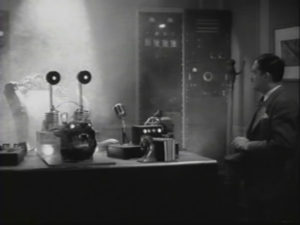
Margot seems to excel at screaming. Her serial character is a far cry (no pun intended) from the often self-composed and capable agent from the pulps. She’s much more in the vein of the radio Margot Lane who plays the professional victim. She’s someone to be placed into danger. And she screams several times in each chapter, to securely drive home that point.
The core pulp characters are here. The Shadow, Lamont Cranston, Margot Lane, Harry Vincent, Joe Cardona, and Commissioner Weston. None of The Shadow’s other agents appear in the serial. My guess is that adding them would have made the serial more expensive, and serials were notorious for being shot on a low budget. Also, it would probably have made the plots more complicated, something that wouldn’t work well for an audience of kids who were trying to keep track of the plot over a 15-week period.
Harry Vincent, man of many talents
Harry Vincent takes the place of all the agents. He’s sort of a compilation of Hawkeye, Cliff Marsland, and mostly Moe Shrevnitz. “I drive a cab,” is the way he describes himself in chapter five. Only once in the entire serial is his first name mentioned. Margot calls him “Harry” in chapter 13. Other than that, he’s always referred to as “Vincent.”
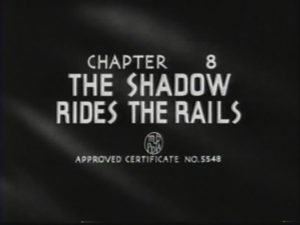
The car that Vincent drives seems to change from one chapter to the next. Often it’s a light-colored taxi with the words “B-B Cab Co.” on the side. But sometimes it’s a black sedan or a dark, old flivver. My guess is that the director selected a car based upon what stock footage he was trying to match for that scene. As you probably know, serials relied heavily on stock footage. No sense smashing up a perfectly good car, when you have stock film footage you can use instead. Just put your actors in a matching vehicle and splice in that stock footage.
Commissioner Weston is pretty much a standard police commissioner. Nothing outstanding. He’s not too bright, but certainly not too dull. He lacks the military bearing of the pulp character. And the mustache; the pulp character of Commissioner Weston sported a military mustache, while the serial character is clean-shaven. But apparently Harry Vincent found his mustache, because the Vincent character here sports a small mustache. In the pulps, you will remember, Vincent was described as smooth-faced.
Joe Cardona is referred to as “inspector” in this serial. You may remember in the pulps he started out as detective and was later promoted to inspector. He was also noted for his hunches in the pulps, something that’s never mentioned in the serial. The serial character seems quite capable, but somewhat nondescript. He doesn’t get to shine; he’s just there.
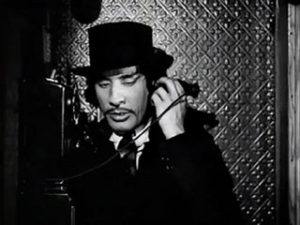
Who is Lin Chang?
A new character has been added to this story. Chinese merchant Lin Chang is another of The Shadow’s disguises. He owns a shop called “The Oriental Bazaar” where many scenes take place. Lin Chang is a friend to the underworld, and as such the disguise allows The Shadow access to important secret information. This character was created exclusively for the serial. There was never any mention of him in the pulps or the radio show.
In those politically incorrect times, Lin Chang was referred to by a racial term common at the time, but which is no longer acceptable. Yes, it’s the “-ink” word. And it’s used by one of the hoodlums in chapter two. So we just ignore it and move on.
The Cobalt Club is just one of several familiar haunts in this chapter play. We only get to see the meeting room in the Cobalt Club, where the leaders of industry gather to discuss The Black Tiger. And The Black Ship is here, although the underworld dive has been turned from a bar into a café. Now it’s The Black Ship Café. At least that’s what the sign over the door reads. But it’s only referred to as The Ship Café. One can only assume they left out the reference to “Black” in deference to the villain, The Black Tiger.
In six separate chapters, the cliffhanger endings have The Shadow being buried by an avalanche of debris, from some sort of an explosion. Then in the following chapter, when the peril is shown resolved, The Shadow is simply shown as climbing out of the rubble. He’s never even hurt!
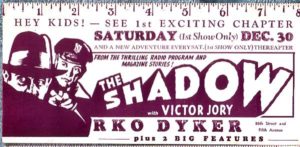
In chapter one, a television studio explodes. The ceiling collapses, and The Shadow is buried under a ton of rubble. But at the beginning of chapter two, he simply crawls from beneath the beams and plaster, and staggers off. As chapter four ends, The Shadow is trapped in a brownstone basement. It explodes. Everything crashes in. And as chapter five opens, we again see The Shadow pulling himself from beneath the debris.
At the end of chapter seven, it’s a warehouse that explodes. Chapter 10 ends with an underground tunnel exploding. Chapter 12 has a laboratory machine exploding and destroying the entire room. And at the end of chapter 14, it’s the Cobalt Club that comes under attack by gas and explosives.
Certain death?
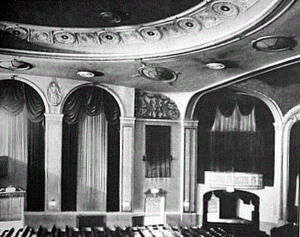
Yet each time, the resolution of last week’s cliffhanger is the same. The Shadow simply wobbles to his feet, dusts himself off, and staggers away. Maybe he’s taking an off-camera swig from that vial of purplish liquid he carries in the pulps. Whatever the explanation, it seems certain that youngsters of 1940 must have started taking his escapes from such explosions for granted. A sort of “crying wolf” by the writers.
Each of the cliffhanger endings is described as “certain death.” By the time I got to chapter 15, I was chuckling every time I saw those inevitable words in the recap to the previous chapter. “Certain death” wasn’t certain at all. Not even close.
As with most serials of the time, there are plenty of inventions in the story. Ray guns, strange explosives, invisibility machines, nitro bulbs, force fields, and so on. It’s enough to keep any adolescent male happy for 15 weekly installments of action and thrills.
The Shadow does a lot of climbing in this serial. He doesn’t get to use those rubber discs from the pulp stories. But even without the suction cups, he’s always climbing walls via a trellis, a downspout, or a fire escape.
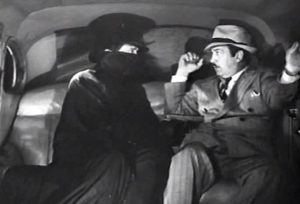
One of the disconcerting things about this serial is that The Shadow appears in his black cloak and slouch hat in broad daylight. In the pulps, he reserved that outfit for night-time use only. But here he runs around in black cloak during the daytime for all to see. Inside buildings. Outside on city streets. It doesn’t seem to matter.
As with all serials, there’s lots of action. Typical of the pulp stories, The Shadow gets in lots of fights. Some gun fights, but mostly fist fights. Those are a staple of nearly every serial I’ve seen. And they’re also a staple of every Shadow pulp mystery I’ve read. Yes, The Shadow was a natural for a serial interpretation.
One of the favorite gimmicks from the pulp stories was to have Harry Vincent dress up as The Shadow to throw off suspicion from Lamont Cranston. It’s used again to nice effect in the serial as well. No one suspects that Lamont Cranston is The Shadow because both were in the same room at the same time.
Not exactly the pulp Shadow…
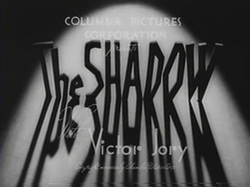
I found the serial very enjoyable, overall. Admittedly, it certainly was different from the pulp magazine stories. And nothing like the radio show. But taking it as a different view of the pulp character allowed me to enjoy it for what it was. I probably shouldn’t have watched the entire thing over a two-day period, because that wasn’t the way it was intended to be viewed.
This serial hasn’t been released on DVD by the studio, but there are some public-domain DVDs available. And you might find it streaming online. Do yourself a favor and find a copy of the serial. And if you can, you might want to set aside a half-hour every Saturday morning to watch one chapter. That’s the way it was meant to be enjoyed. And enjoy it you will!
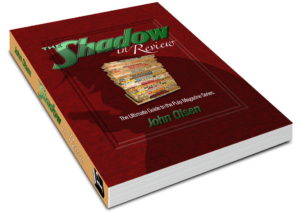 The above was taken from my recently-published book The Shadow in Review: The Ultimate Guide to the Pulp Magazine Series. You can order it direct from the printer for only $10 plus shipping. For more information, click here.
The above was taken from my recently-published book The Shadow in Review: The Ultimate Guide to the Pulp Magazine Series. You can order it direct from the printer for only $10 plus shipping. For more information, click here.
But of course, you’ve already ordered your copy, haven’t you? Ah, The Shadow is proud of you. Maybe, though, you should be thinking about a Christmas present for your pulp friends!
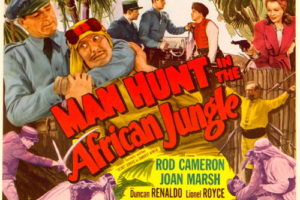

Your tidbit on the spelling of Lane’s first name reminds me of when Margot Asquith, wife of British Prime minister Herbert Asquith, met actress Jean Harlow. Fed up with Harlow’s mispronouncing her name, Margot fired back “My dear, the T is silent…as in Harlow.”
Very funny quote that I hadn’t heard before. I plan on using it in the future!